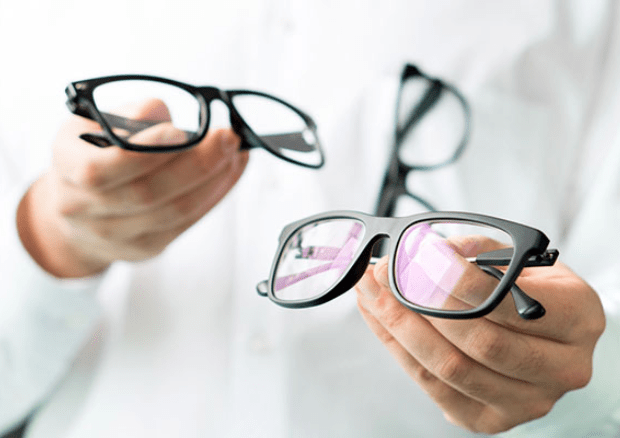How to tell if your progressive lenses are correct?

First, look at yourself in the mirror. Are the lenses sitting in front of your eyes? This is of utmost importance for a number of reasons. In this regard, ask yourself the following questions:
- Are you able to maintain a normal position in your neck and see sharp while focusing in the distance?
- Are you finding it necessary to raise your chin excessively high while reading?
- Are you finding your peripheral vision blurring or moving?
- Are you finding yourself moving reading material off to the side for better focus?
- When walking around, are you experiencing a “swimming” sensation or an overall sense of disorientation?
Don’t be alarmed. Affirmative answers to the above questions in no way mean you are not a suitable candidate for progressives, and most problems are far from insurmountable.
Let’s take a closer look.
Toward this end, it is often useful to get an overall understanding of how progressives work.
Things You Need to Know About Progressive Lenses

A progressive lens is composed of various zones to provide maximum vision clarity at various distances.
The uppermost portion of a progressive lens is designed for distance viewing, geared to deal with the myriad ways you spend your day—driving your car, taking a walk, spending time with your family and friends, watching television, and so on. Smoothly working down the lens, more toward the middle, there is a funnel shaped “corridor” which gradually widens out as it works its way down. In all progressive lenses, the strength of the lens is distributed in varying increments. Each interval changes vision clarity. Thus, the power of the lens at one point is most suitable for reading. At another point, the power might be more appropriate for intermediate vision, such as working on the computer. Each component of the progressive lens provides a different viewing experience, but each comprises part of a “whole” for comprehensive, sweeping vision.
Sometimes distortion or blurring can occur as your eyes traverse through the corridors into the lens periphery which is also known as swim effect.
Fortunately, with freeform digital lenses, the gold standard of progressives, distortion/blurring issues can be kept at a minimum. You may purchase freeform progressive lenses online from us with free overnight shipping.
So Is There a Best Way to Adapt to Progressives
Well take heart! Solutions are at the ready!
Most people find significant reduction in these problems in as little as one day, although some may require a period of seven days.
If you find it necessary to raise your chin excessively high while reading, the lenses might be fitted too high. If you still can’t read well with the glasses up, the lenses are probably too low.
So what to do?
While looking through a more upper part of the lens, try gazing at an object at an approximate distance of 65 feet or thereabouts, perhaps a robin sitting in a tree down the street.
Is that robin coming through nice and crisply? If not, keep your eyes focused on that bird and gradually lower your chin. Does looking through this raised portion of the lens seem to help? If so, it’s a safe bet that the glasses / lenses are positioned too high .
You may also try to look at the difference in the blurriness on the outer edges of a road sign. If you feel the need to lower your chin and this object still doesn’t appear to be sharp, once again the lenses or frame are positioned too high. You should not have to alter your posture to see clearly, especially in the distance.
On the other hand, maybe your lenses are too low.
Try this: Hold a book in your hands and lower it with your eyes. Avoid moving your chin down as you gaze downward. If raising the glasses up doesn’t improve reading, lenses are too low.
If reading seems to be your nemesis, again, hold a book in your hands and lower it with your eyes. Once again, avoid moving your chin as you look down. Now look down at something to read without lowering your chin.
Now rotate your head to the left and right, using one eye at a time. If you find yourself able to read in a rotated position, your reading zones are out of position.
Here’s a very useful technique: First, try scanning your eyes slowly from side to side, then, in a similar manner, up and down. Your brain and eyes will quickly coordinate with each other and is a very useful tool to locate “sweet spots” to combat the irksome blurriness/distortion issues.
Keep this in mind:
With improved progressive design, you will find yourself developing movement patterns in which you will not be forced to search for clear zones. With somewhat subtle effort, you will learn to automatically point your nose a bit more into the direction you want to see clearly.
What are Some Other Helpful Hints to Maximize Results?
Of vital concern for the new progressive wearer is to appreciate the impact of frame selection. Why? Progressive lenses function better in different sized frames. It is vital that the entire range of vision can fit within the frame. Thus, frames with a very short lens aren’t prone to fit progressives as well as frames with a larger lens, preferably 28 mm tall, or thereabouts. And one shouldn’t underestimate lens shape while we’re at it. Best to stay away from aviator shapes frames along with cat-eyes since both can cut off the bottom portion of the prescription causing a dramatic reduction of reading vision. Seek out shorter frames with rounded edges such as horn-rimmed, retro wingtip, circular, or oval. You should not have to sacrifice aesthetics in this arena. Today there are a variety of optical frames, ranging from the more conservative, the bolder, or even the more “exotic.” Choose one that is compatible with your lifestyle.
Still Having Trouble—Your Eyeglass Professional is Near at Hand
To reiterate, most problems experienced by new progressive wearers are often a result of fitting errors. Before you even receive your progressives, rigorous care is taken to nip difficulties in the bud. At Overnight Glasses, progressive glasses are inspected x3 times to make sure correct alignment and fitting are at their best.
But if blurriness and/or distortion are still inhibiting your vision, please keep this in mind:
Don’t be reluctant to revisit your eyeglass professional if you feel you are not making sufficient progress.
He or she has been extensively trained in this area.
Sometimes simple modifications can carry the day, such as checking fitting height, decreasing the distance between your lenses and eyes, adjusting the nose pads to be closer together, etc.
If you find it necessary, ask your eyeglass professional to actually refit your lenses. We can always redo your order at no extra charge, regardless of the issues.
